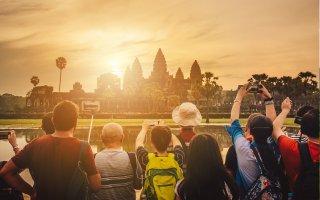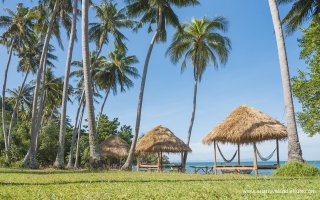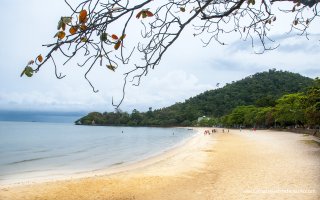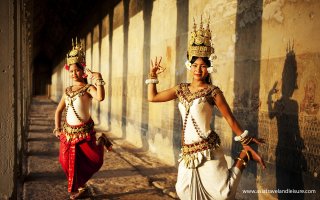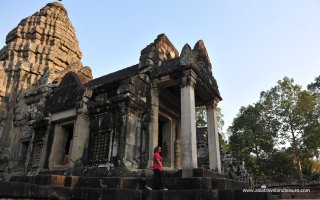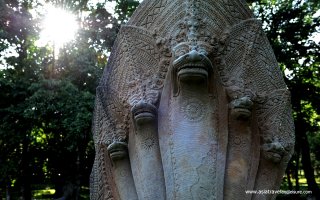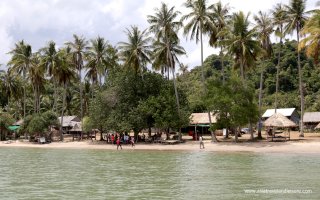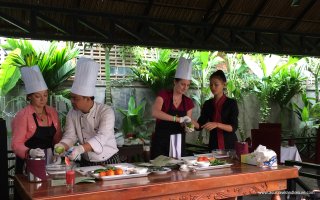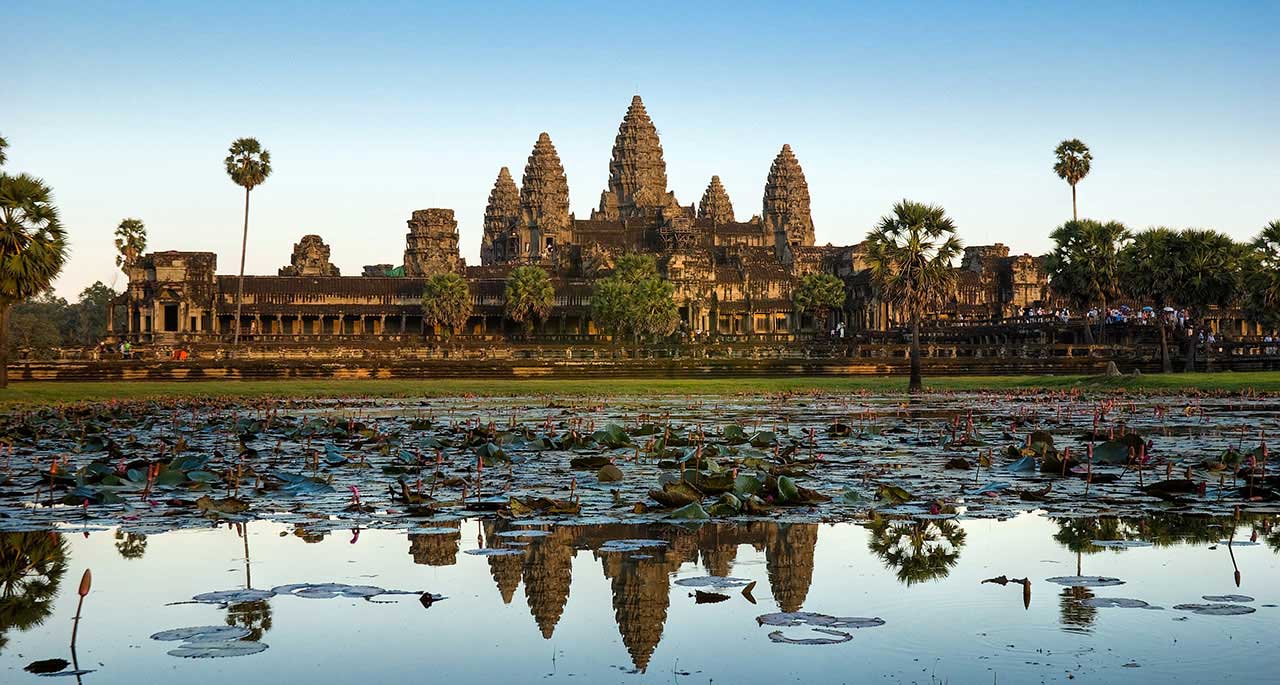
Cambodia, with its rich history, stunning landscapes, and vibrant culture, is a destination worth exploring year-round. In this comprehensive guide, we'll help you navigate Cambodia's climate, pinpoint the ideal seasons for your interests, and provide insider tips to make the most of your trip. Whether you're an adventure seeker, history enthusiast, or culture lover, Cambodia has something special in store for you. Let's dive into the details and plan your dream Cambodian adventure!
The cool season (Nov–Feb) is the peak time for tourism – mild enough to explore the temples in comfort but warm enough to sunbathe by the coast and it is rarely dipping below 20°C. Humidity and temperatures rise slightly during the hot season (March–May), with Phnom Penh and Battambang seeing peak daytime temperatures of 33–38°C.
Cambodia's Climate: A Year-Round Overview
Cambodia is a tropical country with warm temperatures throughout the year. However, the climate is not the same in every season, and it can affect your travel plans and activities.
Cambodia has two main seasons: the dry season and the rainy season.
The dry season runs from November to April, and the rainy season runs from May to October. The dry season is divided into two parts: the cool dry season from November to February, and the hot dry season from March to April.
The rainy season is also divided into two parts: the early rainy season from May to July, and the late rainy season from August to October. The seasons are influenced by the monsoon winds, which bring different amounts of rainfall and humidity to different regions of the country.
In general, the dry season is the best time to visit Cambodia, as it offers clear skies, sunny days, and comfortable temperatures. The rainy season can be more challenging, as it brings heavy rains, floods, landslides, and mosquitoes.
However, the rainy season also has its advantages, such as lush green landscapes, fewer tourists, lower prices, and spectacular sunsets. In this guide, we will explore the pros and cons of each season in more detail, and help you decide when is the best time to visit Cambodia for your preferences and interests.
Best time to travel to Cambodia
The best time to visit Cambodia is the dry season from November to March, when the weather is sunny and dry. The wet season from May to October is hot and humid, with frequent rain. The shoulder seasons from April and October-November are less crowded and still pleasant.
Here is a more detailed breakdown of the weather in Cambodia by season:
- Dry season (November to March): This is the best time to visit Cambodia, as the weather is sunny and dry. The average temperature is around 28 degrees Celsius (82 degrees Fahrenheit). The days are long and sunny, and the nights are clear and cool. This is the time to visit the temples of Angkor Wat and explore the other historical sites in Cambodia.
- Wet season (May to October): The wet season is from May to October. The average temperature is around 27 degrees Celsius (81 degrees Fahrenheit). The days are hot and humid, and there are frequent afternoon thunderstorms. The wet season is not a bad time to visit Cambodia, but you should be prepared for rain. If you are planning to visit during this time, it is best to choose activities that can be done indoors, such as visiting museums or temples.
- Shoulder seasons (April and October-November): The shoulder seasons are April and October-November. The weather is still pleasant during these times, and there are fewer crowds than during the peak season. This is a good time to visit if you are looking for a less crowded experience.
Dry Season: November to April
The dry season in Cambodia lasts from November to April, and it is influenced by the northeast monsoon winds that bring dry and cool air to the country. The dry season is divided into two sub-seasons: the cool dry season from November to February, and the hot dry season from March to April.
The cool dry season is the most popular time for tourists, as it offers clear skies, sunny days, and comfortable temperatures. The average temperature ranges from 21°C to 32°C, and the humidity is low. This is the best time to visit Cambodia's cultural and historical attractions, such as Angkor Wat, Phnom Penh, and Battambang. You can also enjoy the beautiful beaches and islands on the southern coast, such as Sihanoukville, Koh Rong, and Kep.
The cool dry season is also the peak season for festivals and events, such as the Water Festival in November, the Angkor Wat International Half Marathon in December, and the Chinese New Year in January or February. However, the cool dry season also has some disadvantages, such as higher prices, more crowds, and lower water levels in some rivers and lakes .
The hot dry season runs from March to April, and it is the hottest time of the year in Cambodia. The average temperature can reach up to 40°C, and the humidity is high. This can make traveling uncomfortable and exhausting, especially in the inland areas.
The hot dry season is not ideal for sightseeing or outdoor activities, but it can be a good time to visit some of the less crowded destinations, such as Mondulkiri, Ratanakiri, and Preah Vihear. You can also take advantage of the lower prices and fewer tourists during this time. The hot dry season is also a good time to witness some of the local traditions and celebrations, such as the Khmer New Year in April, which is the most important festival in Cambodia. During this time, people celebrate with music, dance, games, and water splashing.
Rainy Season: May to October
The rainy season in Cambodia lasts from May to October, and it is influenced by the southwest monsoon winds that bring moist and warm air to the country. The rainy season is divided into two sub-seasons: the early rainy season from May to July, and the late rainy season from August to October. The early rainy season is the transition period from the hot dry season to the wet season, and it is marked by occasional showers and thunderstorms. The average temperature ranges from 25°C to 35°C, and the humidity is moderate.
This is a good time to visit Cambodia's coastal areas, as they receive less rainfall than the inland regions. You can also enjoy some of the natural attractions, such as waterfalls, lakes, and wildlife sanctuaries.
The early rainy season is also a good time to experience some of the cultural and religious events, such as the Royal Ploughing Ceremony in May, which marks the start of the rice planting season, and the Visak Bochea Day in May or June, which commemorates the birth, enlightenment, and death of Buddha.
The late rainy season runs from August to October, and it is the wettest time of the year in Cambodia. The average temperature ranges from 24°C to 32°C, and the humidity is high. This is the most challenging time to visit Cambodia, as it brings heavy rains, floods, landslides, and mosquitoes.
The rainfall can disrupt transportation, infrastructure, and activities, especially in rural areas. The roads can become muddy and slippery, and some of them may be closed or inaccessible. The temples can also become crowded and slippery, and some of them may be closed for renovation.
However, the late rainy season also has some benefits, such as lower prices, fewer tourists, and more opportunities for photography. The rainfalls create stunning scenery, such as lush green rice fields, misty mountains, and colorful sunsets.
The water levels in rivers and lakes also rise, making it possible to explore some of the floating villages and flooded forests. The late rainy season is also a good time to witness some of the unique festivals and celebrations, such as the Pchum Ben Festival in September or October, which is a time to honor the ancestors and offer food to the monks, and the Bon Om Touk Festival in October or November, which is a water festival that features boat races, concerts, fireworks, and water splashing.
Festivals and Events by Season
Cambodia is a country rich in culture and traditions, and there are many festivals and events that take place throughout the year. Depending on the season, you can witness different celebrations that reflect the history, religion, and lifestyle of the Cambodian people. Here are some of the festivals and events that you can experience by season:
Dry Season (November to April):
- Khmer New Year (Choul Chnam Thmey) - April: Celebrated in mid-April, Khmer New Year is the most important holiday in Cambodia. It involves water festivals, traditional dance performances, and various ceremonies to mark the new year. People also clean their houses, visit their relatives, and exchange gifts. Khmer New Year is a time of joy, gratitude, and hope for the future.
- Victory Day Over Genocide (January 7th) - January: Commemorates the end of the Khmer Rouge regime in 1979, which killed about 2 million people in Cambodia. Ceremonies and parades take place in Phnom Penh, where people pay tribute to the victims and honor the survivors. Victory Day Over Genocide is a day of remembrance, justice, and reconciliation.
- Chinese New Year (Date varies) - January or February: Celebrated by the Chinese community in Cambodia, as well as other ethnic groups that follow the lunar calendar. Chinese New Year is a time of family reunion, prosperity, and good luck. People decorate their houses with red lanterns, paper cutouts, and couplets. They also enjoy dragon and lion dances, fireworks, and feasts.
Rainy Season (May to October):
- Pchum Ben (Ancestors' Day) - September or October: This Buddhist festival lasts for 15 days and is dedicated to paying respects to deceased relatives. Families visit pagodas to make offerings to monks and ancestors, who are believed to return to earth during this time. People also dress in white clothes, abstain from meat, and perform charitable deeds. Pchum Ben is a time of piety, gratitude, and merit-making.
- Water Festival (Bon Om Touk) - October or November: Celebrated on the full moon of the Buddhist month of Kadeuk. This festival marks the reversal of the flow of the Tonle Sap River, which is a natural phenomenon that affects the livelihoods of millions of Cambodians. The highlight of the festival is the boat races that take place on the river in Phnom Penh, where thousands of participants and spectators gather. The festival also features illuminated boat processions, concerts, fireworks, and water splashing.
- Royal Ploughing Ceremony (Date varies) - May: This ancient Brahman ritual, presided over by the king or a representative, marks the beginning of the rice planting season. It's a colorful event with oxen plowing fields and predictions made about the year's harvest based on what they eat from trays of rice, corn, beans, sesame, grass, water, and wine. The ceremony also symbolizes the fertility and prosperity of the land and the people.
Tips for Planning Your Cambodia Trip
Planning a trip to Cambodia requires careful consideration to ensure a smooth and enjoyable experience. Here are some essential tips to help you plan your Cambodia trip:
Research Visa Requirements: Check the visa requirements for Cambodia based on your nationality. You may need to obtain a tourist visa in advance or upon arrival.
Choose the Best Time to Visit: Consider the weather when planning your trip. The dry season (November to April) is the most popular time to visit Cambodia, but it can be crowded and expensive. The rainy season (May to October) offers lush landscapes and lower prices, but occasional downpours and floods.
Create an Itinerary: Decide which cities and attractions you want to visit. Common destinations include Phnom Penh, Siem Reap (home to Angkor Wat), and coastal towns like Sihanoukville. You can also explore some of the less visited places, such as Mondulkiri, Ratanakiri, and Preah Vihear.
Budget Wisely: Calculate your travel budget, including accommodation, transportation, food, and activities. Cambodia is generally affordable, but budgeting helps you make the most of your trip.
Health Precautions: Consult a travel clinic or your healthcare provider for recommended vaccinations and health precautions. Malaria is a concern in some areas, so take necessary medications and use mosquito repellent. You should also avoid drinking tap water and eating raw or uncooked food.
Travel Insurance: Purchase comprehensive travel insurance to cover unexpected events, including medical emergencies, trip cancellations, and lost luggage. Travel insurance can save you a lot of money and hassle in case something goes wrong during your trip.
Pack Appropriately: Pack lightweight and breathable clothing, comfortable shoes for walking, and modest attire for visiting temples. Don't forget essentials like sunscreen, a hat, and insect repellent. You should also bring a raincoat or umbrella for the rainy season, and a warm jacket or sweater for the cool dry season.
Respect Local Customs and Culture: Cambodia is a predominantly Buddhist country, so show respect for temples and monks by dressing modestly and removing your shoes when required. Learn some basic Khmer phrases and greet locals with a smile. Avoid touching people's heads or pointing your feet at them, as these are considered rude gestures. You should also be aware of the history of genocide and civil war in Cambodia, and avoid bringing up sensitive topics or making jokes about them.
Stay Safe: Cambodia is generally safe for travelers, but exercise caution in crowded areas and safeguard your belongings. Be mindful of scams and be wary of overpriced services or goods. Avoid walking alone at night or in unfamiliar areas, and always use licensed taxis or tuk-tuks. You should also follow the local laws and regulations, and avoid any involvement with drugs or illegal activities.
Currency and Payment: The official currency is the Cambodian Riel (KHR), but US dollars are widely accepted. Carry a mix of both currencies for convenience. Credit cards are also accepted in many places, but you may be charged a fee or a higher exchange rate. ATMs are available in most cities, but they may charge a withdrawal fee or have a low limit. You should also keep some small bills or coins for tipping or bargaining.
Local Cuisine: Don't miss the opportunity to try Cambodian cuisine, which includes dishes like amok (a coconut milk-based curry), fish and rice, and fresh fruit. Street food can be delicious but choose clean vendors and avoid ice or unpeeled fruits. You can also enjoy some of the international cuisines, such as Chinese, Thai, or French. You should also try some of the local drinks, such as palm wine, rice wine, or iced coffee.
Transportation: Plan your transportation within Cambodia. Tuk-tuks, taxis, and buses are common modes of transport. You can also rent a car, a motorbike, or a bicycle for more flexibility and convenience. However, you should be careful of the traffic and road conditions, and always wear a helmet and follow the rules. You can also take a boat or a train for some scenic routes.
Stay Informed: Stay updated on local news and travel advisories. Register with your embassy or consulate if required for added safety. You can also download some useful apps, such as Google Maps, Google Translate, or XE Currency Converter for your convenience.
Responsible Tourism: Practice responsible tourism by respecting the environment and local communities. Avoid activities that harm wildlife or exploit vulnerable populations. Support local businesses and social enterprises that benefit the people and the planet. You can also volunteer or donate to some of the NGOs or charities that work in Cambodia.
Immerse Yourself: Take the time to learn about Cambodia's history and culture. Visit museums and historical sites to gain a deeper understanding of the country's past. Engage with locals and learn from their stories and perspectives. Participate in some of the cultural activities, such as cooking classes, art workshops, or meditation sessions. Enjoy the natural beauty and diversity of Cambodia's landscapes and wildlife.
Note: This information was accurate when it was published, but can change without notice. Please be sure to confirm all details directly with Travel Consultants of Cambodia Tours in question before planning your trip.
